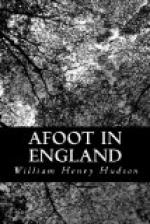Occasionally I met and talked with an old man employed at the cathedral. One day, closing one eye and shading the other with his hand, he gazed up at the building for some time, and then remarked: “I’ll tell you what’s wrong with Salisbury—it looks too noo.” He was near the mark; the fault is that to the professional eye it is faultless; the lack of expression is due to the fact that it came complete from its maker’s brain, like a coin from the mint, and being all on one symmetrical plan it has the trim, neat appearance of a toy cathedral carved out of wood and set on a green-painted square.
After all, my thoughts and criticisms on the cathedral, as a building, were merely incidental; my serious business was with the feathered people to be seen there. Few in the woods and fewer on the windy downs, here birds were abundant, not only on the building, where they were like seafowl congregated on a precipitous rock, but they were all about me. The level green was the hunting ground of many thrushes—a dozen or twenty could often be seen at one time—and it was easy to spot those that had young. The worm they dragged out was not devoured; another was looked for, then another; then all were cut up in proper lengths and beaten and bruised, and finally packed into a bundle and carried off. Rooks, too, were there, breeding on the cathedral elms, and had no time and spirit to wrangle, but could only caw-caw distressfully at the wind, which tossed them hither and thither in the air and lashed the tall trees, threatening at each fresh gust to blow their nests to pieces. Small birds of half a dozen kinds were also there, and one tinkle-tinkled his spring song quite merrily in spite of the cold that kept the others silent and made me blue. One day I spied a big queen bumble-bee on the ground, looking




